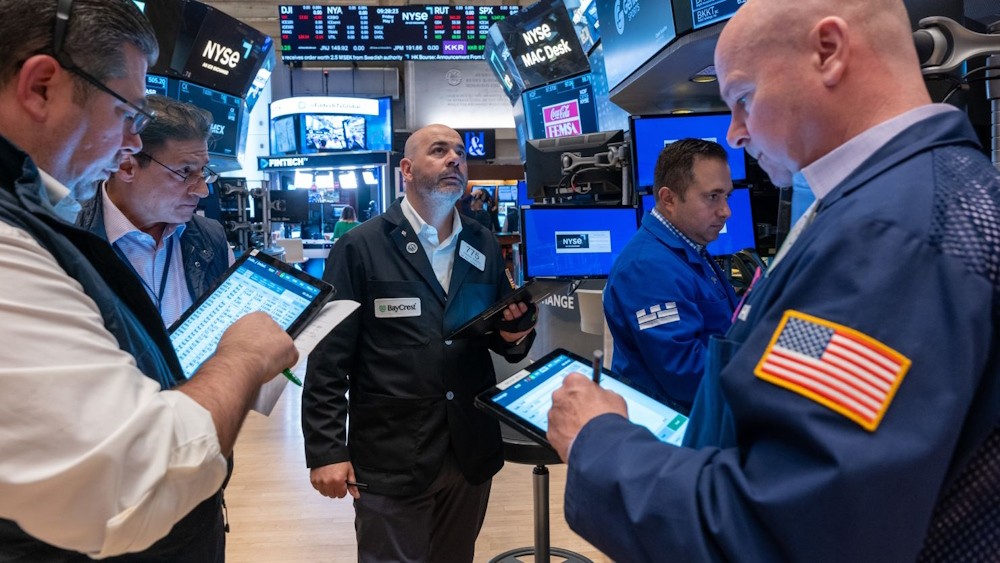
Dow Futures exhibit a slight decline as market participants shift their focus to the resumption of U.S.-China trade discussions in London. Markets are optimistic that the ongoing discussions will result in a reduction of trade tensions between the world’s two largest economies, which have been in conflict over matters such as tariffs and export controls. Elsewhere, Apple is set to deliver a closely-watched keynote address at its annual developers conference, while Chinese export growth slows in May. U.S. stock futures indicated a downward trend on Monday, as market participants anticipated upcoming trade discussions between the U.S. and China, alongside significant inflation data scheduled for release later this week. The Dow futures contract experienced a decline of 46 points, equivalent to 0.1%, while S&P 500 futures decreased by 6 points, also 0.1%. Meanwhile, Nasdaq 100 futures saw a reduction of 39 points, representing a 0.2% drop.
The primary indices on Wall Street concluded the trading session on a positive note on Friday, driven by a robust U.S. labor market report for May that exceeded expectations, alongside President Donald Trump’s announcement regarding today’s meeting between U.S. and Chinese officials in London (more below). Shares in Tesla rebounded from a slump that stemmed in part from a verbal and online brawl between CEO Elon Musk and Trump. At the close of trading, the S&P 500 was positioned above 6,000 for the first time since February 21.
Intensive negotiations between the U.S. and China at a confidential venue in London are poised to capture significant attention from the markets on Monday. Investors exhibit optimism regarding the potential rapprochement between the world’s two largest economies, particularly after a phase characterized by heightened trade tensions. Both parties remain in contention regarding Trump’s threat of increased tariffs and the availability of rare earth minerals from China, notwithstanding a preliminary agreement established in Geneva last month that encompassed a temporary suspension and reduction of retaliatory levies. Trump’s so-called “reciprocal” duties on China have been suspended until August 12.
Treasury Secretary Scott Bessent, U.S. Trade Representative Jamieson Greer, and Commerce Secretary Howard Lutnick are set to represent Washington in the discussions, with Vice Premier He Lifeng leading China’s delegation. Last week, Trump engaged in a telephone conversation with his Chinese counterpart, Xi Jinping, lasting over an hour. Trump indicated that the dialogue primarily centered on trade and reached a “very positive conclusion.” However, a Chinese government account reported that Xi advised Trump to retract his aggressive trade policies and refrain from actions that would support Taiwan.
In addition to political developments, market participants will be closely monitoring Apple’s upcoming annual Worldwide Developers Conference, set to commence on Monday with the company’s customary keynote address. The event generally reveals insights into forthcoming software updates from Apple, expected to be released later this year. Apple is expected to introduce a new numbering system for its operating system, transitioning from a sequential series to a model based on the year. Apple’s iOS 26 is reportedly set to feature significant design changes; however, details remain sparse, with the primary focus on possible enhancements to the artificial intelligence-driven Apple Intelligence service. In the interim, Apple’s anticipated enhancement to integrate additional AI capabilities into its Siri voice assistant is unlikely to materialize this week, as the company indicated three months prior that the upgrade was experiencing delays beyond initial expectations. A perceived lack of progress on AI has somewhat diminished sentiment regarding Apple, resulting in a decline of over 16% in the company’s shares thus far this year.
In May, China’s export growth experienced a decline, reaching a three-month low, as the nation contended with the impact of U.S. tariffs on its shipments. Customs data indicated that China’s exports to the U.S. decreased by 34.5% compared to the previous year in value terms, marking the most significant decline since the onset of the COVID-19 pandemic disrupted global trade in early 2020. Overall exports, a crucial component of the nation’s substantial trade surplus, continued to grow in May, though at a pace that fell short of expectations, with a notable decline in the rate of export growth. Exports experienced a year-on-year growth of 4.8%, falling short of the anticipated 5% increase and declining from the 8.1% growth recorded in the previous month. However, the nation’s imports declined significantly more than anticipated in May, indicating subdued domestic demand in the context of heightened economic uncertainty and lackluster consumer spending. Chinese imports decreased by 3.4% year-over-year, contrasting with an anticipated decline of 0.9%, thereby exacerbating their downturn from a 0.2% decrease in the preceding month.
Oil prices experienced a decline on Monday; however, they have managed to hold onto the majority of the gains accrued in the previous week, as market participants closely monitored developments from the U.S.-China trade discussions taking place in London. Brent futures experienced a decline of 0.5%, settling at $66.16 per barrel, while U.S. West Texas Intermediate crude futures decreased by 0.4%, reaching $64.30 per barrel. The potential for a U.S.-China trade agreement has enhanced the risk appetite among certain investors and provided support for oil prices, fueled by expectations that such a deal could stimulate economic growth and subsequently increase energy demand. Brent experienced an increase of 4%, while WTI saw a rise exceeding 6% last week, marking their initial weekly gain in three weeks.
